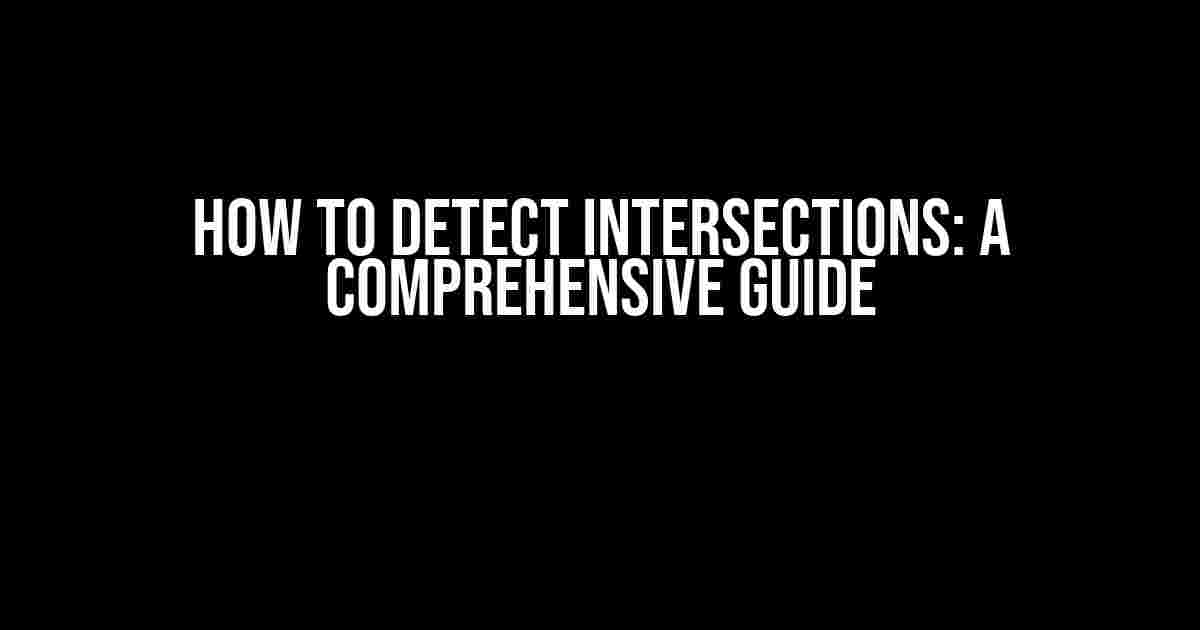Ever wondered how to detect intersections in computer science and mathematics? You’re not alone! Intersection detection is a fundamental concept in various fields, including computer graphics, game development, robotics, and more. In this article, we’ll dive into the world of intersection detection, exploring the different methods and techniques to help you master this crucial skill.
What is Intersection Detection?
Intersection detection is the process of determining whether two or more geometric objects, such as lines, curves, or surfaces, intersect or overlap. In other words, it’s about finding the point or points where these objects meet. This concept is essential in various applications, including:
- Computer-Aided Design (CAD)
- Computer-Aided Manufacturing (CAM)
- Computer Graphics
- Game Development
- Robotics
- Geographic Information Systems (GIS)
Types of Intersections
Before we dive into the detection methods, let’s explore the different types of intersections:
Point-Point Intersection: Two points intersect if they have the same coordinates.
Line-Line Intersection: Two lines intersect if they share a common point.
Line-Curve Intersection: A line intersects a curve if it touches the curve at a single point.
Curve-Curve Intersection: Two curves intersect if they share one or more common points.
Surface-Surface Intersection: Two surfaces intersect if they share a common curve or point.
Methods for Detecting Intersections
Now that we’ve covered the basics, let’s explore the various methods for detecting intersections:
Brute Force Method
The brute force method involves checking every possible pair of objects to see if they intersect. While simple, this approach is inefficient and impractical for large datasets.
for each object1 in objects:
for each object2 in objects:
if object1.intersects(object2):
print("Intersection found!")
Bounding Volume Hierarchies (BVH)
BVH is a more efficient method that uses a hierarchical representation of objects to reduce the number of intersection checks. This approach is particularly useful for complex scenes and large datasets.
bvh = BoundingBoxHierarchy(objects)
for each object in objects:
for each other_object in bvh.get_potential_colliders(object):
if object.intersects(other_object):
print("Intersection found!")
Ray Casting
Ray casting is a popular method used in computer graphics and game development. It involves shooting a ray from a given point and checking if it intersects with other objects in the scene.
ray = Ray(origin, direction)
for each object in objects:
if object.intersects(ray):
print("Intersection found!")
Separating Axis Theorem (SAT)
SAT is a more advanced method used for detecting collisions between convex polygons. It’s based on the idea that if two polygons don’t intersect, there must be a line that separates them.
def sat(polygon1, polygon2):
for each edge in polygon1.get_edges():
normal = edge.get_normal()
if polygon2.is_separated_by(normal):
return False
return True
Matrices and Vectors
Using matrices and vectors, we can detect intersections by performing mathematical operations on the objects’ coordinates. This method is particularly useful for 2D and 3D geometry.
matrix1 = Matrix([[x1, y1], [x2, y2]])
matrix2 = Matrix([[x3, y3], [x4, y4]])
if matrix1.intersects(matrix2):
print("Intersection found!")
Implementation in Programming Languages
Now that we’ve covered the methods, let’s explore how to implement intersection detection in popular programming languages:
| Language | Library/Framework | Example Code |
|---|---|---|
| Python | matplotlib | |
| JavaScript | THREE.js | |
| C++ | CGAL |
Real-World Applications
Intersection detection has numerous real-world applications, including:
- Collision detection in video games
- Robot motion planning and control
- Computer-aided design (CAD) and computer-aided manufacturing (CAM)
- Geographic information systems (GIS)
- Computational geometry and computer graphics
Conclusion
In conclusion, intersection detection is a fundamental concept in computer science and mathematics. By mastering the various methods and techniques outlined in this article, you’ll be well-equipped to tackle complex problems in game development, robotics, CAD, and more. Remember to choose the most suitable method for your specific use case, and don’t hesitate to explore the wealth of resources available online.
Happy coding, and happy intersecting!
Frequently Asked Question
Get ready to uncover the secrets of detecting intersections like a pro!
What are the different approaches to detect intersections?
There are several approaches to detect intersections, including the Brute Force algorithm, Bounding Box method, Separating Axis Theorem, and the Sweep and Prune algorithm. Each approach has its own strengths and weaknesses, and the choice of method depends on the specific use case and requirements.
How does the Brute Force algorithm work for detecting intersections?
The Brute Force algorithm involves checking every possible pair of shapes or lines for intersection. This approach is simple to implement but can be computationally expensive for large datasets. It’s like checking every single combination of possibilities – tedious, but effective!
What is the Separating Axis Theorem, and how is it used for intersection detection?
The Separating Axis Theorem is a mathematical concept that states that if two convex objects do not intersect, there must be a line that separates them. This theorem is used to detect intersections by projecting the shapes onto different axes and checking for overlap. It’s like finding the perfect separator to keep things apart!
What are some common pitfalls to avoid when detecting intersections?
Some common pitfalls to avoid include failing to consider edge cases, using an incorrect algorithm for the specific use case, and neglecting to optimize the intersection detection algorithm for performance. It’s like navigating a obstacle course – stay alert and avoid those pesky pitfalls!
How can I optimize intersection detection for better performance?
Optimizing intersection detection involves using techniques such as spatial partitioning, broad-phase detection, and caching. These techniques can significantly reduce the number of intersection checks and improve overall performance. It’s like fine-tuning a machine – get it running smoothly and efficiently!

